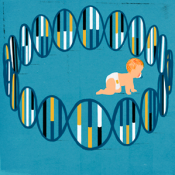The CRISPR children
By Vivien Marx,
Nature Biotechnology
| 11. 24. 2021
Three years after the ‘CRISPR babies’ burst into the public eye and caused outrage, their fate remains shrouded in secrecy amid swirls of rumors. Many people contacted for this story refused to speak about the babies, who are now purportedly healthy toddlers. Some would speak to Nature Biotechnology only on condition of anonymity. Others believe that the unethical work conducted in He Jiankui’s lab at Southern University of Science and Technology in Shenzen can be openly discussed without infringing on the children’s privacy and dignity. This could help the children and their parents plan for the future.
A full understanding of the health risks faced by the children due to their edited genomes may lie beyond the reach of current technology. But emerging knowledge on the potentially genotoxic effects of gene editing may help guide the children’s physicians about what to look for.
Born to an uproar
Three years ago, the world was in uproar after a journalist broke the news about two babies born with genomes edited with CRISPR-Cas9. He Jiankui had been invited to speak in the...
Related Articles
Several recent Biopolitical Times posts (1, 2, 3, 4) have called attention to the alarmingly rapid commercialization of “designer baby” technologies: polygenic embryo screening (especially its use to purportedly screen for traits like intelligence), in vitro gametogenesis (lab-made eggs and sperm), and heritable genome editing (also termed embryo editing or reproductive gene editing). Those three, together with artificial wombs, have been dubbed the “Gattaca stack” by Brian Armstrong, CEO of the cryptocurrency company...
By Lucy Tu, The Guardian | 11.05.2025
Beth Schafer lay in a hospital bed, bracing for the birth of her son. The first contractions rippled through her body before she felt remotely ready. She knew, with a mother’s pit-of-the-stomach intuition, that her baby was not ready either...
By Emily Glazer, Katherine Long, Amy Dockser Marcus, The Wall Street Journal | 11.08.2025
For months, a small company in San Francisco has been pursuing a secretive project: the birth of a genetically engineered baby.
Backed by OpenAI chief executive Sam Altman and his husband, along with Coinbase co-founder and CEO Brian Armstrong, the startup—called...
By Robyn Vinter, The Guardian | 11.09.2025
A man going by the name “Rod Kissme” claims to have “very strong sperm”. It may seem like an eccentric boast for a Facebook profile page, but then this is no mundane corner of the internet. The group where Rod...




